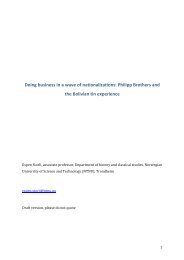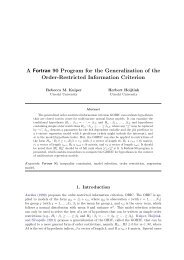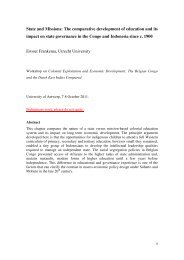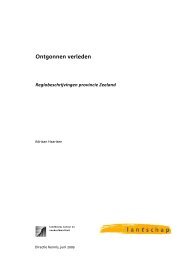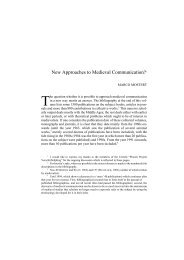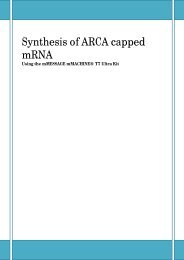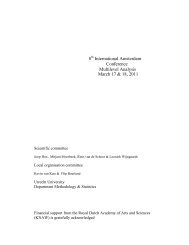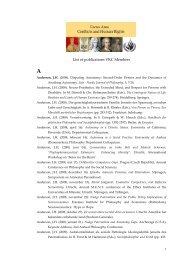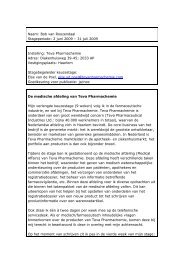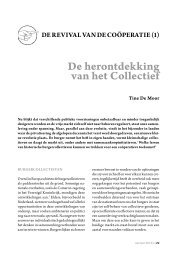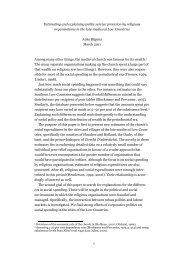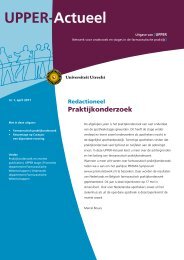Family Structure and Business Organization: Sephardic ... - Partner
Family Structure and Business Organization: Sephardic ... - Partner
Family Structure and Business Organization: Sephardic ... - Partner
Create successful ePaper yourself
Turn your PDF publications into a flip-book with our unique Google optimized e-Paper software.
Draft – Not for circulation without permission<br />
all partners were socii in solidum <strong>and</strong> in infinitum. Following this Roman law institution, each<br />
partner was liable for the total amount of any debts incurred by another associate or contracted in<br />
the company’s name. This full <strong>and</strong> mutual obligation was occasionally spelled out in business<br />
letters, as when the Livorno branch of Ergas & Silvera acknowledged itself accountable “en<br />
solidum per dhos nostros de Aleppo” to someone new in Livorno. 49<br />
Bound in solidum to their relatives in Aleppo (“i nostri d’Aleppo” or “nostros Ergas e<br />
Silvera de Aleppo,” as they called them in their letters), Ergas & Silvera in Livorno could make<br />
promises <strong>and</strong> give orders on their behalf. 50 Mutual agency was particularly appealing to agents<br />
<strong>and</strong> clients who traded between the northwestern <strong>and</strong> southeastern shores of the Mediterranean.<br />
In 1704, the Livorno branch of Ergas & Silvera reminded correspondents in Cyprus that they<br />
were inseparable from those in Aleppo (“perché siamo di casa”). 51 To persuade costumers <strong>and</strong><br />
creditors that it was safe to deal with a bilateral partnership it was necessary to give them<br />
evidence that all promises would be honored by either branch. 52<br />
At times, creditors’ confidence in these bilateral partnerships was shaken. In 1756,<br />
Abraham Pardo Roques brought a lawsuit against his creditor Isaac Abedana before the judges of<br />
the Jewish community of Livorno (massari). Pardo Roques claimed that Abendana owed him<br />
625 pieces of eight in the form of a bill of exchange, which the Belilios of Venice had drawn<br />
upon him. Abendana denied that he had any obligation to pay this bill of exchange because the<br />
year before the Belilios of Aleppo had gone bankrupt. Padro Roques presented the court with<br />
excerpts from business letters that he received from the Belilios as well as a declaration signed<br />
by ten Livornese merchants in support of his claim that the two Belilios partnerships – “Jacob &<br />
Joseph Belilios” of Venice <strong>and</strong> “Isaac <strong>and</strong> Joseph Belilios” of Aleppo – were actually one, or at<br />
least mutually liable. But the massari rejected this proof <strong>and</strong> judged against Pardo Roques,<br />
arguing that, although they were close relatives, the Belilios of Aleppo <strong>and</strong> Venice constituted<br />
two separate partnerships because they operated with two different company names (ragioni<br />
sociali). 53 The head judge was Isaac Baruch Carvaglio, someone likely familiar with the risks of<br />
joint liability. We don’t know whether the same reasoning was upheld in similar lawsuits<br />
<strong>and</strong> transactions in the future. One time, Abraham Ergas, son of Moses, signed with his own name alone because the<br />
letter contained delicate <strong>and</strong> rather secretive instructions to a traveling agent; ASF, LCF, 1957, letter to Moses<br />
Cassuto in Florence (8 July 1743).<br />
49 ASF, LCF, 1931, letter to Aguiar Raposo & sons in Livorno (29 October 1706).<br />
50 Examples in ASF, LCF, 1931, letter to Zuanelli <strong>and</strong> Iolotta in Venice (15 March 1705); ASF, LCF, 1935,<br />
letter to Lazzaro Sacerdoti in Genoa (15 February 1715).<br />
51 ASF, LCF, 1931, letter to Courei <strong>and</strong> Cruvellier in Cyprus (18 December 1704). For another example,<br />
see ASF, LCF, 1931, letter to Stefano Ceccato in Venice (20 January 1708): “tanto qui che in Aleppo, dove haviamo<br />
la nostra casa con le nostre Ergas e Silvera di quale vi prometiamo un pontuale e bon trattare...”.<br />
52 Ergas & Silvera’s account books in Livorno do not include transactions made in Aleppo. The existence<br />
of two separate sets of account-books may at first appear in contradiction with the mutual liability of the two<br />
branches of this partnership. In practice, however, given the difficulty of balancing accounts between Livorno <strong>and</strong><br />
Aleppo <strong>and</strong> the lack of international auditing systems, the senior partners in Livorno may have purposefully chosen<br />
to keep separate accounts. It is reasonable to speculate that they gave Elijah Silvera some initial capital to set up his<br />
business in Aleppo <strong>and</strong> told him to manage it, hoping that, in the event of bankruptcy in Livorno, his goods <strong>and</strong><br />
credits would not be requisioned, <strong>and</strong> viceversa.<br />
53 The massari issued their sentence on 27 May 1757. On 21 June 1757, Pardo Roques declared that he<br />
would not appeal the sentence to a higher civil tribunal. ACEL, Tribunale dei Massari, filza 283, ins. 17.<br />
12



